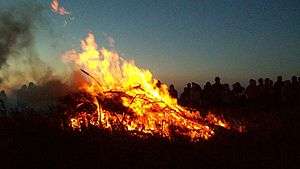Castle an Dinas, St Columb Major
Castle an Dinas is an Iron Age hillfort at the summit of Castle Downs near St Columb Major in Cornwall, England, UK (grid reference SW945624) and is considered one of the most important hillforts in the southwest of Britain. It dates from around the 3rd to 2nd century BCE and consists of three ditch and rampart concentric rings, 850 feet (260 m) above sea level. During the early 1960s it was excavated by a team led by Dr. Bernard Wailes of the University of Pennsylvania during two seasons of excavation.
Arthurian legend


Traditionally, Castle an Dinas is the hunting lodge (hunting seat) of King Arthur, from which he rode in the Tregoss Moor hunt.[1] A stone near St Columb (now lost) allegedly bears the four footprints of his horse made whilst hunting.[2]
The earliest written history was written by William of Worcester during his visit to Cornwall in 1478. He noted that legend says that the fort was the place where Gorlois, Duke of Cornwall and husband of King Arthur's mother, died.
Civil War
In March 1646, during the English Civil War, Sir Ralph Hopton's Royalist troops camped for two nights within the rings of the fort.[3] Here they held a Council of War where it was decided that they would surrender to the Parliamentarians. Only Hopton and Major-General Webb voted against. A few days later Hopton surrendered at Tresillian Bridge near Truro.
Other notable occurrences

Ghost army An extraordinary event that took place at the site was recorded by Cornish historian Samuel Drew, a ghost army was seen in the sky above Castle an Dinas around the end of the 18th century : (if true, a most unusual but documented form of mirage.)
In 1867, Henry Jenner heard a story from an old man at Quoit, near Castle an Dinas, who had seen the ghosts of King Arthur's soldiers drilling there, and remembered the glancing of the moonbeams on their muskets![4]
Murder In 1904 a young woman was murdered on the site by a jealous lover, he then took his own life.[5]
Midsummer The Old Cornwall Society hold their traditional annual midsummer bonfires here on the highest point of the fort.
The legend of John Trehenban

In 1671 a man called John Trehenban (pronounced TREM-on) (1650–1671) of St Columb Major, murdered two young girls and was sentenced to imprisonment in a cage on Castle an Dinas, and starved to death.
The murder of the two young girls is recorded in the Parish Register.[6]
23 June 1671 Anne daughter of John Pollard of this Parish and Loveday Rosevear (aged 17), daughter of Thomas Rosevear of St Enoder were barbarously murdered on the day before in the home of Captain Peter Pollard at the bridge by one John Trehenban the son of Humphrey and Cissily Trehenban of this Parish at about 11 O' clock in the forenoon upon a market day.
- Trehenban pretended to help in finding the murderer riding on horseback following the bloodhounds. His hat blew off and the dogs wouldn't leave it. Eventually he confessed.[7]
- The lane where the bloodhounds picked up the scent is still known as 'Tremmons lane'.
- He was placed in a cage which sat on a large rock. This rock is still to be seen and local people used to say that if you ran around this rock fifty times you would hear his chains rattle.
- Tremmon begged a passing woman for some food. All she had were a few tallow candles which he ate ravenously.
- According to local historian Marshel Arthur, local people used to refer to a no-gooder as 'a right Tremmon'.
Castle-an-Dinas mine
From 1916 to 1957 it was the site of Cornwall's largest wolfram mine.[8] Many of the old buildings and workings remain standing. The mine is the type locality for the mineral Russellite.[9] Other minerals found here include: Arsenopyrite, Cacoxenite, Löllingite, Phlogopite, Russellite Topaz Turquoise[10]
See also
| Wikimedia Commons has media related to Castle an Dinas. |
References
- ↑ Anthony D. Hippisley Coxe, Haunted Britain, pg. 21, McGraw-Hill Book Company, New York 1973
- ↑ "A Gazetteer of Arthurian Topographic Folklore". Retrieved 7 March 2006.
- ↑ "Sir Ralph Hopton – Lord Hopton, 1st Baron of Stratton". Retrieved 7 March 2006.
- ↑ Extracted notes of Henry Jenner from the Journal of the Royal Institution of Cornwall, Volume XIX, Part 1., 1912, pp46-89
- ↑ "Terrible tragedy at St. Columb, young lady found". West Briton & Cornwall Advertiser. 16 June 1904. Retrieved 7 March 2006.
- ↑ St Columb Major Parish registers 1539 – 1780, pages 229 – 230
- ↑ A view from Hensbarrow, Cornish Magazine, Sept' 1961, page 150, article by Marshel Arthur.
- ↑ Castle-an-Dinas Wolfram Mine, Cornwall
- ↑ Embrey, P. G.; Symes, R. F. (1987). "The Mines and Mining". Minerals of Cornwall and Devon. London: British Museum (Natural History). p. 54. ISBN 0-565-00989-3.
- ↑ Castle-an-Dinas Mine, St Columb Major, Belowda Area, St Austell District, Cornwall, England, UK
- 2nd season of excavations in summer 1963 (article in The Times, 13 Aug 1963)
Further reading
- Brooks, Tony (2001) Castle-an-Dinas 1916–1957: Cornwall's premier tungsten mine with brief comparative histories of other wolfram mines in Cornwall & West Devon. St. Austell, Cornwall: Cornish Hillside Publications ISBN 1-900147-15-7
External links
Coordinates: 50°25′31″N 4°53′40″W / 50.42541°N 4.89453°W